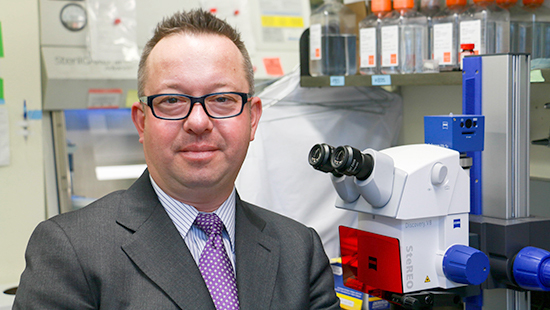April 11, 2018
Why is epilepsy so common in autism? A CBC affiliate, Peter Penzes, NU, discovers how mutated Cntnap2 may destabilize inhibitory neuronal connections in the autistic brain.
A new publication from the Penzes group, NU, describes the interplay between a major autism risk gene, Cntnap2 and its partner CASK, in the development of stable interneuronal connections in the brain inhibitory neuronal circuits. The paper, recently published in Molecular Psychiatry, demonstrates that deficiency in CNTNAP2 protein causes diminished branching of the dendrites of certain brain inhibitory neurons. The authors further imply that, in consequence, these inhibitory neurons become incapable of “calming the brain” making it prone to over-excitation and epileptic outbursts. Future studies are planned to screen for drugs targeting the CNTNAP2/CASK interactions that could prevent autism-associated seizures and other comorbidities linked to the mutations in Cntnap2. In 2016, Penzes, participated in the 14th Annual CBC Symposium, “Genetics of Neurological and Psychiatric Disorders”, where he gave a talk about genetic risk factors in autism. Congratulations on the continued successful work in the field!
When Kids’ Autistic Brains Can’t Calm Down
Mutation is linked for first time to seizures in autism and is new drug target
Northwestern Medicine News Center | by MARLA PAUL | April 5, 2018
One-third of children who have autism spectrum disorder also have epilepsy. It’s related to a major autism risk gene, which is mutated in patients with autism. But scientists didn’t now why the mutation, catnap2, caused seizures.
In a study published in Molecular Psychiatry, Northwestern Medicine scientists have discovered the mutation acts like a bad gardener in the brain. It shrinks the neurons’ tiny branches and leaves — its dendrite arbors and synapses — that enable brain cells to relay vital messages and control the brain’s activity. The shrinkage causes a breakdown in message delivery.
An important message that gets lost? Calm down!
In people with the mutation, inhibitory neurons — whose job is to keep things tranquil in the brain and slam the brake on excitatory neurons — don’t grow enough branches and leaves to communicate their Zen-like message, the scientists found. That leads to seizures.
The mutation, CNTNAP2 or “catnap2,” works as a team with another mutated gene, CASK, implicated in mental retardation. As a result, scientists have a new target for drugs to treat the disorder.

Peter Penzes, PhD, the Ruth and Evelyn Dunbar Professor of Psychiatry and Behavioral Sciences, was the lead author of the study that explored autism’s link to epilepsy.
“Now we can start testing drugs to treat the seizures as well as other problems in autism,” said lead author Peter Penzes, PhD, the Ruth and Evelyn Dunbar Professor of Psychiatry and Behavioral Sciences. “Patients with the mutation also have language delay and intellectual disability. So a drug targeting the mutation could have multiple benefits.”
Next Penzes’s team will do high-throughput screening of molecules with the goal of reversing these abnormalities in patients with autism.
Catnap2 is an adhesive molecule that helps cells stick together, in this case helping the synapses adhere to the dendrites. It’s a difficult molecule to target with drugs, Penzes said.
But catnap2’s partner, CASK, is a social butterfly enzyme that interacts with many other molecules. It can more easily be inhibited or activated with drugs. Penzes’s team will screen drugs to activate it because that appears to maintain healthy dendrite branches. When scientists blocked CASK in the study, dendrites didn’t grow.
Penzes is also director of the new Center for Autism and Neurodevelopment, which aims to speed the development of new treatments.
Autism spectrum disorder is a highly prevalent neurodevelopmental disorder — affecting one in 68 children — characterized by a range of symptoms, including difficulty with communication and social interactions. People with autism also often have other neurodevelopmental disorders and comorbidities, such as intellectual disabilities, seizure disorders or epilepsy, anxiety and depression.
The study was supported by grants NS100785, MH097216 and F30MH096457 from the National Institute of Mental Health of the National Institutes of Health.
Source:
Adapted (with modifications) from Northwestern Medicine News Center, by Marla Paul, posted on April 5, 2018.
Citation:
Gao R, Piguel NH, Melendez-Zaidi AE, Martin-de-Saavedra MD, Yoon S, Forrest MP, Myczek K, Zhang G, Russell TA, Csernansky JG, Surmeier DJ, Penzes P. CNTNAP2 stabilizes interneuron dendritic arbors through CASK. Mol Psychiatry. 2018 Apr 2. [Epub ahead of print] (PubMed)
Peter Penzes has following ties to CBC:
- 14th Annual CBC Symposium (2016):
▸ “Genetics of Neurological and Psychiatric Disorders”
Peter Penzes (NU) — Invited Speaker - Symposium Recap:
▸ Recognizing the Significance of Genetics in Neurological and Psychiatric Disorders
